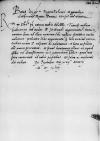List #2709
Bona Sforza do Ioannes DANTISCUSPiotrków, 1544-03-18
| odebrano Heilsberg (Lidzbark Warmiński), 1544-03-28 Rękopiśmienne podstawy źródłowe:
| ||||
Tekst + aparat krytyczny + komentarzZwykły tekstTekst + komentarzTekst + aparat krytyczny
Reverendo in Christo Patri, domino
Reverende in Christo Pater, sincere nobis dilecte.
Tametsi nullum habeamus ad Vestram Paternitatem scribendi argumentum, tamen euntem hunc ad illam nuntium litteris nostris dimittere vacuum noluimus, malentes litteras argumento quam litteris nuntium carere. Quibus Vestram Paternitatem visemus ac salutamus, et laeta ac felicia illi omnia precamur, et simul hortamur illam, ut si quid istic vel domesticarum vel externarum rerum superinscribed⌈rerumrerum superinscribed⌉ habet, quod nos scire conveniat, id nobis perscribat.
Et salva ac incolumis diu valeat.
Ex


 BCz, 1601, p. 728
BCz, 1601, p. 728